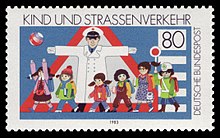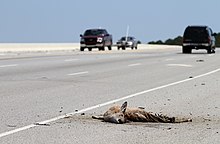Road traffic
Public road traffic takes place on all areas that are dedicated to the general public by federal, state or local law (public traffic area ). Non-dedicated traffic areas (actually or conditionally public traffic areas) such as the petrol station area, which are open to the general public for traffic purposes, are also summarized here. Anyone who uses these areas is a road user .
Areas such as company or private premises that exclude general access through barriers or other structural measures do not count as public traffic areas. The Road Traffic Regulations , the Road Traffic Act and the Driving License Ordinance generally do not apply to these areas.
The road traffic system includes traffic routes , means of transport and other facilities such as petrol stations , parking lots and multi-storey car parks .
Road traffic is perceived by pedestrians , by muscle-powered vehicles (e.g. carts , bicycles ) and vehicles moved by motor power ( motor vehicles ) ( motor traffic ). State institutions, such as the Federal Motor Transport Authority , the Federal Highway Research Institute , the Federal Office for Goods Transport or the police , monitor traffic and traffic courts provide legal security . Also Repairs , gas stations, garages , driving schools , accessory shops, automobile clubs and journals are important players.
In most cases, the public sector is responsible for the road network . Motorized means of transport, however, mostly belong to companies or private individuals .
Theoretical models for describing the road traffic flow are, for example, the fundamental diagram and the Nagel-Schreckenberg model .
meaning
In the context of motorization , road traffic only became increasingly important after the Second World War . Before that, the railroad was the main mode of transport for almost 100 years. Road traffic was only important as a feeder and distributor. Today, road traffic is the most important mode of transport in most countries . An efficient road transport system is essential for modern economies and the mobility of citizens.
In Germany, over 90% of passenger and freight transport services take place on roads.
The effectiveness of road traffic decreased e.g. B. in Switzerland, because there are more and more and larger cars on the road.
Road transport is one of the most important infrastructure facilities, see also transport infrastructure .
Traffic rules
Because of its high risk potential, participation in road traffic is heavily regulated by law. In Germany the most important legal bases are the Road Traffic Act (StVG), the Road Traffic Regulations (StVO), the Driving License Regulations (FeV) and the Road Traffic Licensing Regulations (StVZO).
hazards
People

Traffic causes a lot of property damage and personal injury ( road deaths and injuries). In Germany in the 1970s, after a previously sustained increase since 1950, there was a high of almost 20,000 road deaths per year, most of which were attributable to road traffic. In the meantime, after a long-lasting downward trend, according to data from the Federal Statistical Office, a new low of 4160 people has been reported for road deaths on German roads. Around 1.2 million people die in road traffic worldwide every year. In 2001 there were 114 fatalities from road accidents for every 1 million people in 29 countries of the developed world.
In addition, there are health impairments from road traffic noise and exhaust gases . In Germany, for example, 11,000 people die each year as a result of air pollution from road traffic; Deaths that could potentially be avoided. That number is 3.5 times the death toll from accidents.
Animals
- In Germany, a total of almost 233,000 accidents with game occurred in the 2014/2015 hunting year (April 2014 - March 2015). There are around 194,000 accidents with roe deer, around 21,500 accidents with wild boar , around 4,000 in fallow deer and around 3,200 in red deer . A good 212,800 roe deer, wild boar and stags lost their lives on German roads in 2015.
- In 2014 a total of 72,081 wild animals died on Austria's roads, 338 people were seriously injured in traffic accidents involving wild animals and two people died in the process.
- Every year tens of thousands of larger animals such as deer, foxes , martens , hedgehogs and well over 100,000 amphibians perish on Swiss roads . Over 8,000 deer are killed on Swiss roads every year. Over 100 people are injured in collisions with animals every year.
- It is estimated that between 350,000 and 27 million birds die on European roads every year .
See also
- 3-A method ( age - attention - intention , for assessing partners in road traffic)
- Private transport
- Road and path construction
- Transportation
literature
- Kurt F. de Swaaf: What road traffic really costs. In: Der Spiegel from January 5, 2007, ISSN 0038-7452 , (so far unique Swiss study).
- Christoph Maria Merki : The bumpy triumph of the automobile, 1895–1930. For the motorization of road traffic in France, Germany and Switzerland. Böhlau, Vienna 2002, ISBN 3-205-99479-5 .
- Elmar Oberegger : "Automobilism" "- A whim of the history of transport. Origins, structures, future prospects. Sattledt 2015.
Web links
- Elmar Oberegger: “Automobilism” - a whim of transport history. Origins, structures, future prospects. Sattledt 2015. ( Online )
Individual evidence
- ↑ § 1 StVO and VwV StVO
- ↑ a b c d Helmut Nuhn, Markus Hesse: Verkehrsgeographie. Schöningh, Paderborn [a. a.] 2006, ISBN 3-8252-2687-5 , p. 35.
- ^ Helmut Nuhn, Markus Hesse: Verkehrsgeographie. Schöningh, Paderborn [a. a.] 2006, ISBN 3-8252-2687-5 , p. 36 f.
- ↑ Hanspeter Guggenbühl: Why the efficiency in road traffic has decreased. In: Infosperber.ch . October 25, 2019, accessed November 18, 2019 .
- ↑ Federal Statistical Office ( Memento of October 24, 2010 in the Internet Archive )
- ^ Johannes Lelieveld : Clean air in the Anthropocene . In: Faraday Discussions . tape 200 , 2017, p. 693-703 , doi : 10.1039 / c7fd90032e .



